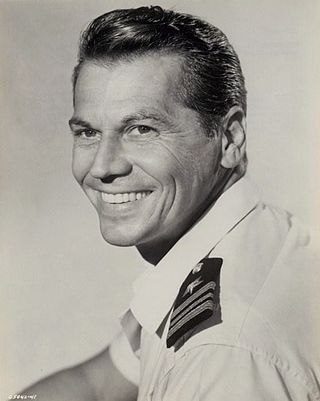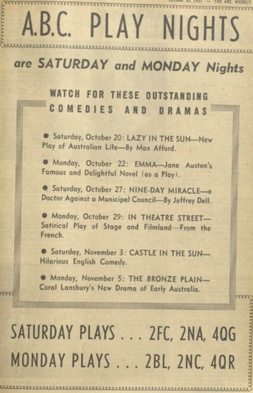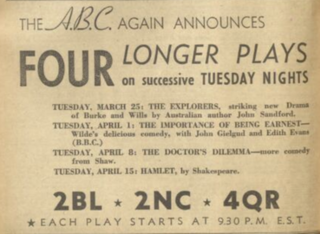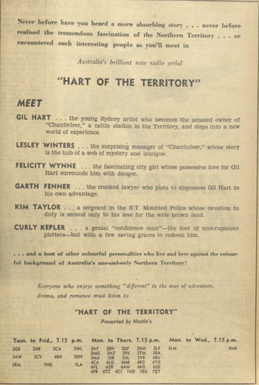Related Research Articles

Ronald Egan Randell was an Australian actor. After beginning his acting career on the stage in 1937, he played Charles Kingsford Smith in the film Smithy (1946). He also had roles in Bulldog Drummond at Bay (1947), Kiss Me Kate (1953), I Am a Camera (1955), Most Dangerous Man Alive (1961) and King of Kings (1961).

Ronald Grant Taylor was an English-Australian actor best known as the abrasive General Henderson in the Gerry Anderson science fiction series UFO and for his lead role in Forty Thousand Horsemen (1940).

Harold Pierce Cazneaux, commonly referred to as H. P. Cazneaux, was an Australian photographer; a pioneer whose style had an indelible impact on Australian photographic history. In 1916, he was a founding member of the pictorialist Sydney Camera Circle. As a regular participator in national and international exhibitions, Cazneaux was unfaltering in his desire to contribute to the discussion about the photography of his times. His career between the Wars established him as "the country's leading pictorial photographer".

Wide Boy is a 1952 British second feature ('B') crime film directed by Ken Hughes and starring Susan Shaw, Sydney Tafler and Ronald Howard.
Strong is the Seed is a 1949 Australian drama film, about the life of agronomist and plant breeder William Farrer.
Red Sky at Morning is a 1944 Australian melodrama set during the 19th century based on a play by Dymphna Cusack. It features an early screen performance by Peter Finch, who plays a convict who falls in love with the wife of a sea captain.
Lloyd Berrell was a New Zealand actor who played Reuben "Roo" Webber in the original Sydney production of Summer of the Seventeenth Doll. He worked extensively in Australian radio and theatre, appearing in a large portion of the films being shot locally at that time. He also starred in the original stage production of Sumner Locke Elliott's Rusty Bugles as well as numerous productions for the Mercury Theatre.
The Round Australia Trial was a long distance rally, which was run on multiple occasions between 1953 and 1998, circumnavigating Australia. Its early years were tremendously popular as the roads through large portions of the country, particularly west of Adelaide, were unformed. Automobile manufacturers enthused over the event as it provided a particularly severe test event for their products, proving their cars were able to stand up to whatever conditions remote Australia could provide. Early editions of the event were heroic tests and were front-page fodder for the newspapers of the era.
Wicked is the Vine is a 1947 radio play by Sumner Locke Elliott that was later adapted for American television.

The Pathway to the Sun is a 1949 novel by Australian author E. V. Timms. It was the second in his Great South Land Saga of historical novels.
The Crater is a 1948 Australian radio play by Sumner Locke Elliot that was later adapted for American television.

Lazy in the Sun is a 1951 Australian radio drama by Max Afford. It was one of Afford's most acclaimed works. It explored the notion of Australia's responsibilities to the world.

The Sundowners is a 1953 Australian radio serial based on the novel of the same name by Jon Cleary. It was a 15-minute morning serial for the ABC starting in April 1953 and played as a night-time serial in November of that year.

The Explorers is a 1952 Australian radio play about the Burke and Wills expedition by John Sandford. It was Sandford's first play.
Stormy Petrel is a 1948 Australian radio serial about the career of William Bligh by Rex Rienits. It aired Mondays to Thursdays at 6.40pm on the ABC.
Man of Two Tribes is a 1953 Australia radio serial based on the stories of Arthur Upfield about Detective Inspector Napoleon "Bony" Bonaparte. Morris West adapted several of Upfield's stories.

Hart of the Territory is a 1951 Australian radio serial by Anthony Scott Veitch and produced by Colin Cragin. It was set in the Northern Territory. Sydney John Kay wrote the music. Extensive research went into the scripts.
The Thin Air is a 1952 American television play that was an episode of Philco Television Playhouse.
John Robert Unicomb was an Australian actor and stage manager who had early successes in radio and was later influential in the history of theatre in Tasmania. His brother Morris Unicomb was also a successful actor. The surname has often been mis-spelled "Unicombe".
References
- ↑ Papers to do with Dustry Portrait at Vanderbilt
- ↑ "Television this week". The Kansas City Star. 30 March 1952. p. 6D.
- ↑ "RADIO PLAY BILL". Daily Mirror. No. 3713. New South Wales, Australia. 29 April 1953. p. 24 (Cable Edition). Retrieved 20 September 2024– via National Library of Australia.
- ↑ "ARTHUR POLKINCIIORNE'S". The Sun. No. 13, 153. New South Wales, Australia. 26 March 1952. p. 17 (LATE FINAL EXTRA). Retrieved 20 September 2024– via National Library of Australia.
- 1 2 Australian Broadcasting Commission. (25 April 1953), "COMMERCIAL", ABC Weekly, Sydney: ABC, nla.obj-1687508341, retrieved 20 September 2024– via Trove
- ↑ "Hear Here". Daily Mirror. No. 3684. New South Wales, Australia. 25 March 1953. p. 36 (Late Final Extra). Retrieved 20 September 2024– via National Library of Australia.
- ↑ "GUY CRITTENDEN'S 2WL RADIO ROUND-UP". South Coast Times and Wollongong Argus . Vol. LIII, no. 32. New South Wales, Australia. 27 April 1953. p. 2 (South Coast Times AND WOLLONGONG ARGUS FEATURE SECTION). Retrieved 20 September 2024– via National Library of Australia.
- ↑ "Chinese bass for concert tour". The Sun. No. 13, 483. New South Wales, Australia. 28 April 1953. p. 22 (LATE FINAL EXTRA). Retrieved 20 September 2024– via National Library of Australia.
- ↑ "John Quinn's RADIO ROUND-UP". The Mail (Adelaide) . Vol. 43, no. 2, 134. South Australia. 2 May 1953. p. 59. Retrieved 20 September 2024– via National Library of Australia.
- ↑ "THE WEEK IN WIRELESS". The Age . No. 30, 578. Victoria, Australia. 2 May 1953. p. 16. Retrieved 20 September 2024– via National Library of Australia.